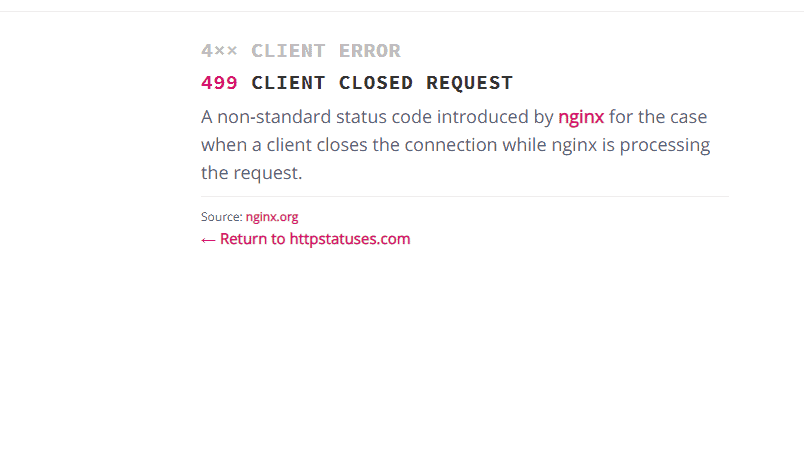A non-standard status code introduced by nginx for the case when a client closes the connection while nginx is processing the request.
Often you’ll see requests appear with a status code 499 while browsing at your pull zone logs. Although this may seem alarming, 499 errors are common and often occur over connections such as mobile networks that can suffer from a load interruption etc., or even when an ad blocker blocks a file request, for example.
These are not codes that are not directly returned to the user, 499 is just an internal server code that indicates that before processing the request and receiving the reply, the client closed the connection.
What is 499 Code Error?
The Minds behind NGINX, a high performance web server, developed the error 499 code. As a popular web server, NGINX developed 499 code HTTP error to manage their unique error. To begin with, HTTP error 499 is part of a large list of HTTP error codes, all linked to different online activity requests. Different organizations link to each other and ask for unique data. HTTP error 499 simply means the client, the recipient of the request, did not complete the request. The 499 error code focuses on client-related mistakes as opposed to other error codes relating to prohibited requests or missing data.
This is not unique to HTTP error 499. There are various reasons why the request could not be processed by the client, and a 499 error code ended up. An example of an incident that contributed to HTTP code 499 is that the client had to shut down on data traffic. It is quite likely, for example, that a content delivery network needs to close the request as it is already filled with certain data-related problems, such as a high volume of cache. HTTP error 499 happened because the content delivery network had to deal with further internal problems during the request process and as a customer it had to cancel the order.
Where can i see 499 error code?
Usually HTTP code 499 appears in NGINX logs. NGINX 499, being a web server, is able to identify that the problem is not in the server itself, or the entity that sent the request. HTTP error 499 basically means the client shuts the request through the server in the middle of processing. The 499 error code puts better light on something that happened to the client, which is why the request is not possible. But don’t worry: HTTP answer code 499 is totally not your fault.
499 error complete overview
As has been created, HTTP code 499 is not the fault of the server or the requesting party, and maybe not the fault of the client either. For various clients HTTP code 499 may occur differently. Earlier it was established that the client could be a website or an app, and these two experiences errors differently. Too much traffic could have been loaded on a website leading to HTTP code 499, or the request was from flawed algorithms that caused problems within the website. Due to faulty programming the HTTP error can also occur. Many applications are web-based, for example, and the server must make the effort to reach out to its cloud users. There was however a problem with the online app coding. HTTP error 499 occurs due to faulty code, as the application can not process the request. This is yet another example of how the web program, the client, led to HTTP code 499.
Learning on Consumer Errors
HTTP code 499 is only one of many error codes connected to the application. In general, the error codes are classified into five categories, labeled in their 3 digits by the first number. Those are all client-based errors for codes 400-499, meaning the server request can not be done at all due to client side issues. The most common group in which HTTP error 499 belongs to is the error 404: File on Found. Unlike HTTP code 499, the 404 code is very straightforward and definite, while the 499 error code generalizes simply that the client can not complete the server request.
If you are interested in learning more about HTTP error 499 and other codes, then it would be a good idea to study how server logs work and how the information stored in such logs can make sense. It will also give you more insight when finding particular clients, such as apps and websites, that end up with the most HTTP code 499, so you can be more aware of what apps and websites you want to visit. Yet being familiar with the 499 error code and other codes in general will help you access the Internet easier.
How to Fix NGINX Timeout – 499 Client Closed Request?
A long-running script that I was trying to load apparently kept “timing out” and leaving a blank screen. There were no records of any errors and I was quite perplexed. I checked every one of the following:
PHP
- max_execution_time set to 0
- max_input_time set to -1
- memory_limit set to 4G
NGINX
- fastcgi_send_timeout 6000 seconds
- fastcgi_read_timeout 6000 seconds
Even stranger, the only mention of the issue in the php / nginx logs was an entry in the nginx log with the HTTP status code 499-” “Client Closed Request.” Initially, I thought my browser was destroying the link after some time, but that didn’t seem to be the case.
There are several HTTP error codes out there, so let’s think about the 499 error code out there. We may also refer to error code 499 as HTTP code 499, or error 499 in HTTP. Yet the 499 error code, whatever you call it, is something worth knowing. HTTP code 499 can occur at any time without you knowing it, so let’s get started with the HTTP error 499.










Leave a Reply